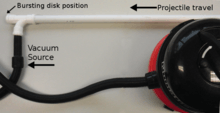Vacuum bazooka
A vacuum bazooka is a pipe-based cannon which uses a vacuum pump (often a vacuum cleaner) to reduce pressure in front of the projectile and therefore propel a projectile as a result of the air pressure acting on its reverse. The concept was originally proposed by Neil Downie in 2001[1] but many variations have been built since.[2][3]
Construction

The vacuum bazooka uses a straight tube which is sealed with a type of bursting disk at the launch end and by the projectile at the other. A tee-piece at the launch end allows application of vacuum. When the projectile is released the air pressure behind the projectile causes it to accelerate towards the vacuum port. When the projectile reaches the vacuum port its momentum causes it to continue past and break through the bursting disk towards the target.[1] A lightweight bursting disk such as a piece of paper can be secured simply by the vacuum action when it is held against the barrel.
The mechanics of the vacuum bazooka are well understood and the concept has been explored extensively by Mark French at Purdue University[4] where engineers have also developed a supersonic variation. The supersonic model uses a De Laval nozzle to fire a ping-pong ball at mach 1.2.[5][6][7]
The velocity of a projectile in a vacuum cannon can be modeled. The maximum velocity is independent of the projectile mass and barrel diameter.[8]
Variations
Several variations have been developed including a belt fed[3] repeating model.
See also
- Spud gun
- Plastic pressure pipe systems
References
- ↑ 1.0 1.1 Downie, Neil A. (2001). Vacuum Bazookas, Electric Rainbow Jelly and 27 Other Saturday Science Projects. Princeton University Press. pp. 70–79.
- ↑ "Vacuum Powered Bazooka". The Naked Scientists. 2008-03-16. Retrieved 2013-10-21.
- ↑ 3.0 3.1 Ansell, Dave (2011-09-23). "Repeating Vacuum Bazookas". The Naked Scientists. Retrieved 2013-10-21.
- ↑ French, R. M.; Gorrepati, V.; Alcorta, E.; Jackson, M. (2008). "The Mechanics of a Ping-Pong Ball Gun". Experimental Techniques 32: 24. doi:10.1111/j.1747-1567.2007.00214.x.
- ↑ French, Mark; Craig Zehrung; Jim Stratton. "A Supersonic Ping Pong Gun" (PDF). Purdue University Department of Mechanical Engineering Technology. Retrieved 2013-10-21.
- ↑ Purdue University College of Technology. "In the news: Ping-Pong balls faster than speed of sound". 2013-02-04. Archived from the original on 2013-02-21. Retrieved 2013-10-21.
- ↑ Didymus, JohnThomas (2013-02-06). "Video: Supersonic Ping-Pong gun fires a ball faster than sound.". Digital Journal. Retrieved 2013-10-21.
- ↑ Ayars, E.; Buchholtz, L. (2004). "Analysis of the vacuum cannon". American Journal of Physics 72 (7): 961. doi:10.1119/1.1710063.